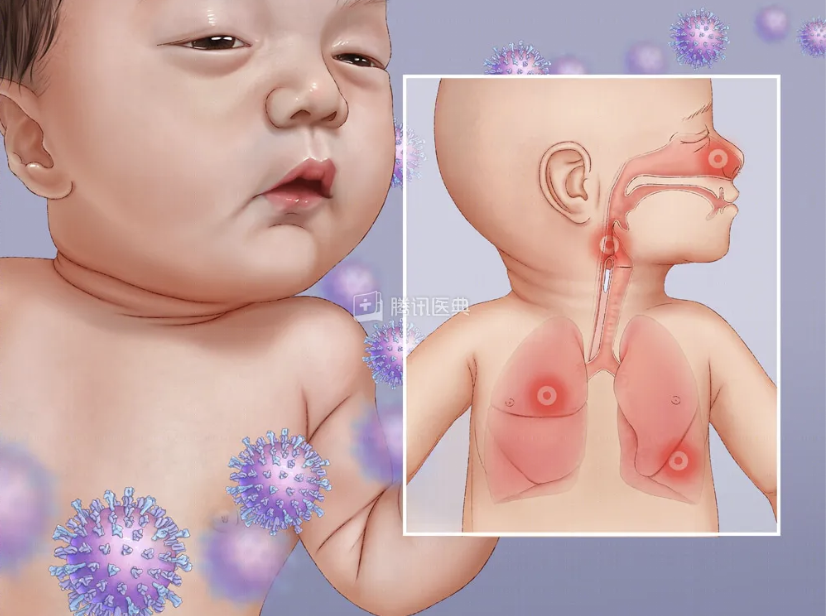Mycoplasma pneumonia has just stopped.
Influenza, noro and new crowns are back in force.
And to add insult to injury.
The syncytial virus has joined the fray.
The other day it was on the top of the charts.
“It’s the fever again.”
“This time it’s a bad cough.”
“It’s like a windpipe. It’s like asthma.”
……
Watching their children in distress.
Parents are anxious.
01
Respiratory syncytial virus.
Is it a new virus?
No, it’s not.
Respiratory syncytial virus (“RSV”) is one of the viruses that can cause pneumonia and is one of the most common respiratory pathogens in paediatrics.
Respiratory syncytial virus is widespread worldwide. In the north of the country, outbreaks peak between October and May each year; in the south, epidemics peak during the rainy season.
This summer, there was an anti-seasonal epidemic.
With the onset of winter and falling temperatures, syncytial viruses are entering a favourable season.
In Beijing, Mycoplasma pneumoniae is no longer the top cause of paediatric visits. The top three are: influenza, adenovirus, and respiratory syncytial virus.
Syncytial virus has risen to third place.
Elsewhere, there has been an increase in children with acute respiratory infections.
Many of these are also due to RSV.
02
Respiratory syncytial virus, what is it?
Respiratory syncytial virus has two characteristics:
It is very lethal.
Almost all children are infected with RSV before the age of 2 years.
It is also the leading cause of hospitalisation for pneumonia, fine bronchitis and even death in children under 5 years of age.
Highly infectious
Respiratory syncytial virus is about 2.5 times more infectious than influenza.
It spreads mainly through contact and droplet transmission. If a patient sneezes face-to-face and shakes hands with you, you may be infected!
03
What are the symptoms that
could be respiratory syncytial virus?
Infection with RSV does not necessarily cause illness right away.
There may be an incubation period of 4 to 6 days before symptoms appear.
In the early stages, children may have a mild cough, sneezing and a runny nose. Some of them are also accompanied by fever, which is usually low to moderate (a few have high fever, up to more than 40°C). Usually, the fever goes down after taking some antipyretic medicine.
Later, some children develop lower respiratory tract infections, mainly in the form of capillary bronchitis or pneumonia.
The baby may experience wheezing or episodes of stridor and shortness of breath. In severe cases, they may also be irritable, and may even be accompanied by dehydration, acidosis and respiratory failure.
04
Is there a specific medicine for my child?
No. There is no effective treatment.
At present, there is no effective treatment of antiviral drugs.
However, parents should not be too nervous:
Respiratory syncytial virus (RSV) infections are usually self-limiting, with most cases resolving in 1 to 2 weeks, and a few lasting about 1 month. Moreover, most of the children are mildly ill.
For “affected” children, the main thing is to supportive treatment.
For example, if nasal congestion is obvious, physiological seawater can be used to drip the nasal cavity; more serious symptoms and high-risk patients should be hospitalised for observation, and be given rehydration fluids, oxygen, respiratory support, and so on.
Generally speaking, parents only need to pay attention to isolation, while keeping the child’s fluid intake adequate, and observing the child’s milk intake, urine output, mental condition, and whether the mouth and lips are dry.
If there is no abnormality, mildly ill children can be observed at home.
After treatment, most children can recover completely without sequelae.
05
In which cases, should I see a doctor immediately?
If you have these symptoms, go to the hospital immediately:
Feeding less than half the usual amount or even refusing to eat;
Irritability, irritability, lethargy;
Increased respiratory rate (>60 breaths/minute in infants, counting 1 breath when the child’s chest goes up and down);
A small nose that deflates with breathing (flaring of the nose);
laboured breathing, with the rib cage of the chest sunken in with the breath.
How can this virus be prevented?
Is there a vaccine available?
At present, there is no relevant vaccine in China.
However, babysitters can prevent the infection by taking these steps -
Breastfeeding
Breastmilk contains lgA which is protective for babies. After the baby is born, it is recommended to breastfeed until the age of 6 months and above.
② Go to less crowded places
During the syncytial virus epidemic season, reduce taking your baby to places where people gather, especially patients with a higher risk of infection. For outdoor activities, choose parks or meadows with fewer people.
③ Wash your hands frequently and wear a mask
Syncytial viruses can survive on hands and pollutants for several hours.
Washing hands frequently and wearing a mask are important measures to prevent transmission. Do not cough on people and use tissue or elbow protection when sneezing.
Hongguan care about your health.
See more Hongguan Product→https://www.hgcmedical.com/products/
If there are any needs of medical comsumables, please feel free to contact us.
hongguanmedical@outlook.com
Post time: Nov-28-2023


